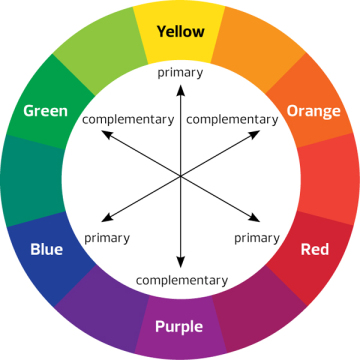When it comes to interior design, color is a powerful tool that can transform a room from dull and uninspiring to vibrant and inviting. Among the various elements contributing to a room’s color scheme, curtains and wall paint play pivotal roles. Understanding how to create harmonious color palettes using these two key components can significantly impact the overall aesthetic of your living space. In this comprehensive guide, we’ll explore the art of harmonizing curtains and wall paint to create stunning, mood-enhancing interiors.
The Art of Color Harmony
Before delving into the world of curtains and wall paint, let’s lay the foundation by understanding the basics of color harmony and how it can influence our surroundings.
Color Theory Essentials
To create harmonious color palettes, it’s essential to grasp the fundamentals of color theory:
Primary Colors
- Primary colors are the building blocks of all other colors.
- They include red, blue, and yellow.
Secondary Colors
- Secondary colors are created by mixing two primary colors.
- These colors are green (blue + yellow), orange (red + yellow), and purple (red + blue).
Tertiary Colors
- Tertiary colors are formed by combining a primary color with a neighboring secondary color.
- Examples include red-orange and yellow-green.

Warm vs. Cool Colors
Understanding the emotional impact of warm and cool colors is crucial in setting the mood for your living space:
Warm Colors
- Warm colors, such as red, orange, and yellow, radiate energy and vibrancy.
- They are ideal for creating lively and dynamic interiors.
Cool Colors
- Cool colors, including blue, green, and purple, exude calm and relaxation.
- They are perfect for fostering tranquil and serene environments.

Color Schemes
The selection of color schemes is central to creating harmonious interiors:
Complementary Color Schemes
- Complementary colors are situated opposite each other on the color wheel.
- Combining complementary colors creates contrast and visual interest.
Analogous Color Schemes
- Analogous colors are neighbours on the color wheel.
- These schemes create a sense of harmony and flow.
Triadic Color Schemes
- Triadic color schemes consist of three evenly spaced colors on the color wheel.
- They offer a balanced and visually appealing composition.

Setting the Stage with Wall Paint
In this chapter, we’ll explore how to select the dominant wall color—the foundation of your interior color palette.
Room Size and Lighting
Consider the physical aspects of your space when choosing a wall color:
Small Rooms
- Light colors can make small rooms appear more spacious and airy.
- Soft pastels and neutrals work exceptionally well.
Large Rooms
- Darker hues can add coziness and intimacy to large, open spaces.
- Deep blues, rich greens, or elegant grays are excellent choices.
Natural Light
- The amount of natural light affects how colors appear throughout the day.
- Test paint samples under different lighting conditions to make an informed choice.
Psychological Effects of Wall Colors
Understand the psychological impact of different wall colors to create the desired mood:
Blue
- Blue promotes tranquility and relaxation, making it ideal for bedrooms and bathrooms.
- Light blue evokes a sense of serenity, while navy exudes sophistication.
Red
- Red is a bold and energizing color that stimulates conversation.
- Use it in dining rooms or social areas to create a lively atmosphere.
Green
- Green signifies harmony and balance, making it suitable for living rooms and home offices.
- Soft greens bring a natural touch, while emerald greens add drama.
Neutral Colors
- Neutrals like beige, gray, and taupe provide versatility and a timeless appeal.
- They serve as excellent backdrops for various interior styles.

Harmonizing Curtains and Wall Paint
Now that you’ve chosen the dominant wall color, it’s time to explore how curtains can complement and enhance your interior design.

Blending vs. Contrasting
- Curtains can either blend in with the wall color for a seamless look or provide contrast for visual interest.
- Determine your preference based on the mood you want to create.
Undertones and Complementary Shades
- To achieve harmony, curtains should share undertones with the wall paint.
- For example, if your walls have warm undertones, choose curtains with similar warm undertones.
Curtain Fabrics and Textures
Consider the fabric and texture of your curtains to add depth and dimension to your color palette:
Fabric Weight
- The weight of the curtain fabric can impact the overall ambiance of the room.
- Heavy fabrics like velvet provide coziness, while sheer fabrics create an airy feel.
Texture
- Texture adds tactile interest to your color palette.
- Consider options like silk, linen, or patterned fabrics to create a multi-dimensional look.
Examples of Complementary Curtain Colors

Let’s delve into specific examples of harmonious curtain and wall paint combinations:
Example 1: Tranquil Blues
- Dominant Wall Color: Soft, pale blue.
- Complementary Curtain Colors: Curtains in shades of aqua and seafoam green.
- Accessories: Coastal-themed decor for a tranquil beachside retreat.
Example 2: Energetic Reds
- Dominant Wall Color: Bold red accent wall.
- Complementary Curtain Colors: Curtains in warm, earthy tones like terracotta and burnt orange.
- Accessories: Vibrant artwork and contrasting decor items.
Exploring Analogous and Triadic Palettes
For those seeking more unique and vibrant color palettes, consider using analogous and triadic schemes:
Analogous Color Palettes
Analogous color palettes use colors that are adjacent to each other on the color wheel. This approach creates a sense of harmony and cohesion:
Example 1: Coastal Oasis
- Analogous Colors: Soft blue, teal, and seafoam green.
- Accessories: Natural textures like rattan, driftwood, and seashells.
Example 2: Nature’s Bounty
- Analogous Colors: Earthy green, mustard yellow, and burnt orange.
- Accessories: Botanical prints and wooden furnishings for a rustic feel.
Triadic Color Palettes
Triadic color palettes consist of three evenly spaced colors on the color wheel, creating a dynamic and balanced look:
Example 1: Playful Vibrance
- Triadic Colors: Red, yellow, and blue.
- Accessories: Bright and whimsical decor items for a playful atmosphere.
Example 2: Modern Elegance
- Triadic Colors: Purple, green, and orange.
- Accessories: Sleek, contemporary furniture and minimalist accents.
Setting the Mood with Color
Your choice of colors can significantly impact the mood and atmosphere of a room:
Serene and Tranquil
To create a serene and tranquil ambiance, consider soft blues and greens:
Color Choices
- Soft blue and green hues evoke calmness and relaxation.
- These colors work well in bedrooms, bathrooms, and reading nooks.
Accessories and Decor
- Incorporate natural materials like wood and stone for a harmonious feel.
- Soft textiles such as cotton and linen enhance comfort.
Vibrant and Energetic
For spaces that exude energy and vibrancy, embrace bold and contrasting colors:
Color Choices
- Opt for vibrant reds, oranges, and yellows to energize a room.
- These shades are perfect for kitchens, dining areas, and home offices.
Accessories and Decor
- Include colorful artwork and decorative elements to enhance the energetic vibe.
- Consider geometric patterns and metallic accents for a modern touch.
Cozy and Inviting
To create a cozy and inviting space, choose warm neutrals and earthy tones:
Color Choices
- Warm neutrals like beige, taupe, and caramel create a sense of comfort.
- Earthy tones such as terracotta and olive green add warmth.
Accessories and Decor
- Layer textures with plush cushions, soft rugs, and tactile curtains.
- Incorporate wooden furniture and soft lighting for a cozy ambiance.
Practical Tips for Execution
Executing your color palette successfully involves careful planning and attention to detail:
Measuring and Choosing Curtain Lengths
Ensure your curtains fit perfectly by measuring your windows correctly:
Measuring Guidelines
- Measure the width and height of your windows accurately.
- Consider whether you want curtains to hang just above the windowsill or all the way to the floor.
Curtain Lengths
- Floor-length curtains create an elegant and timeless look.
- Shorter curtains work well in more casual spaces.
Color Samples and Swatches
To avoid surprises, obtain paint samples and curtain fabric swatches:
Visualizing the Palette
- Use paint samples to visualize how the wall color will look.
- Curtain fabric swatches help you assess how curtains interact with the wall paint.
Lighting Conditions
- Test your color palette in different lighting conditions, including natural and artificial light.
- Evaluate how the colors change throughout the day.
Painting Walls and Hanging Curtains
Follow best practices when painting walls and hanging curtains for a polished appearance:
Preparing Walls
- Properly prepare walls by cleaning, priming, and filling any imperfections.
- Apply two coats of paint for a smooth and consistent finish.
Hanging Curtains
- Ensure curtains are hung at the correct height and width to create a balanced look.
- Consider using curtain tiebacks or holdbacks for an elegant touch.
Real-Life Case Studies
To provide practical inspiration, let’s explore real-life case studies where harmonious color palettes have transformed living spaces:
Coastal Retreat
Design Elements
- Dominant Wall Color: Soft aqua tones reminiscent of ocean waves.
- Complementary Curtain Colors: Curtains in sandy beige with coral accents.
- Accessories: Nautical-themed decor, seashell motifs, and driftwood furnishings.
Atmosphere
- This coastal-inspired palette creates a sense of serenity and relaxation.
- The interplay of soft blue and sandy beige evokes the tranquility of the beach.
Bohemian Chic
Design Elements
- Dominant Wall Color: A vibrant orange accent wall.
- Complementary Curtain Colors: Curtains feature a mix of colorful patterns and textures.
- Accessories: Eclectic furnishings, handmade textiles, and an array of plants.
Atmosphere
- The bold contrast between the orange accent wall and colorful curtains exudes energy.
- The eclectic mix of patterns and textures adds a bohemian and free-spirited vibe.
Conclusion and Call to Action
In conclusion, the art of creating harmonious color palettes with curtains and wall paint is both an art and a science. By understanding color theory, selecting the right wall color, and harmonizing curtain choices, you can transform your living spaces into inviting havens that reflect your style and personality. Whether you prefer serene blues, energetic reds, or cozy neutrals, the power of color is in your hands.
Call to Action
Ready to embark on your color palette journey? Share your color combinations and interior design projects in the comments below. If you have questions or need further guidance, our community is here to help. Happy decorating!
Image Credit: Pexels




One thought on “Creating Harmonious Color Palettes with Curtains and Wall Paint”